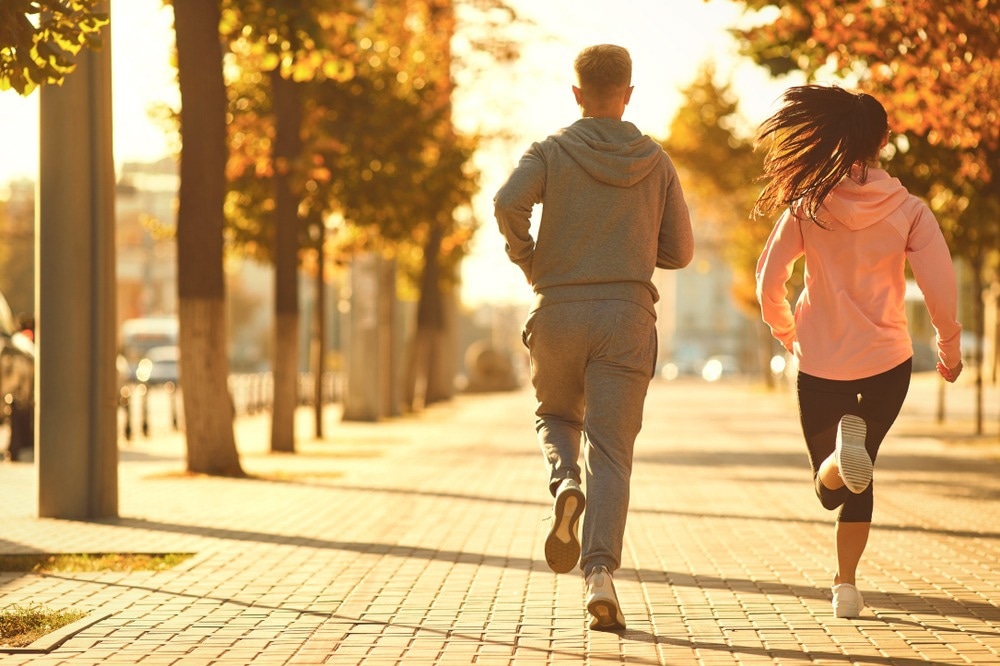A new Diabetologia journal study discusses the associations of breaks in sedentary time and timing of physical activity with insulin resistance and liver fat content among a middle-aged population.

Study: Timing of physical activity in relation to liver fat content and insulin resistance. Image Credit: Studio Romantic / Shutterstock.com
The health impacts of a sedentary lifestyle
The current obesity pandemic is partially due to a sedentary lifestyle and lack of daily physical activity. In addition to obesity, sedentary behaviors can also increase the risk of cardiometabolic diseases such as type 2 diabetes.
Several studies have observed that short breaks in sedentary time can improve cardiometabolic profiles, including reduced glucose and triacylglycerol levels. Conversely, high fasting serum triacylglycerol levels may indicate high liver fat content, which, in turn, is associated with insulin resistance.
Previous reports indicate an association between exercise, reduced liver fat content, and improved insulin sensitivity. Thus, breaks in sedentary time can support a reduction in insulin sensitivity and liver fat, which can help prevent type 2 diabetes.
In addition to the quantity, the timing of physical activity during the day also appears important for metabolic health. Few studies have reported daytime-dependent differences between exercise capacity and associated metabolic pathways; however, these results were inconsistent.
One recent study reported that morning moderate-to-vigorous physical activity (MVPA) was associated with an increased cardiovascular risk in men with type 2 diabetes compared to MVPA later in the day. However, the impact of the timing of physical activity on metabolic health is unknown among the general population.
About the study
The current study was conducted between 2008 and 2012 and involved participants between 45 and 65 years of age, along with a self-reported body mass index (BMI) of 27 kg/m2 or higher.
Study participants visited the Netherlands Epidemiology of Obesity (NEO) study center following an overnight fast of more than 10 hours. Before the visit to the center, the participants completed a questionnaire on their clinical, lifestyle, and demographic information at home.
The study participants wore a combined uniaxial acceleration and heart rate monitor for four consecutive days and nights to assess physical activity, sedentary time, and breaks. Physical activity energy expenditure (PAEE), measured in kJ/kg/day, was used to summarize heart rate information and acceleration. At the same time, metabolic equivalents of task (MET) expressed the intensities of time spent on different activities.
Sedentary time was defined when the intensity spent in activities was less than 1.5 MET. A break in sedentary time was defined when a period of acceleration greater than 0.75 m/s2 followed a sedentary period. Light physical activity was defined as when the activity intensity was greater than 1.5 MET and less than or equal to 3.0 MET, while MVPA was defined as activity exceeding 3.0 MET.
The day was divided into three six-hour blocks, which included 06:00-12:00 (morning), 12:00-18:00 (afternoon), and 18:00-24:00 (evening). The total daily MVPA during each time block was calculated based on which period the participants were most active in the morning, afternoon, or evening.
Blood samples were collected from the antecubital vein of seated participants in a resting position for five minutes. After that, participants drank a liquid-mixed meal comprising 16% energy from protein, 34% from fat, and 50% from carbohydrates.
Two postprandial blood samples were collected 30 and 150 minutes after consumption of the mixed meal. These samples were used to assess postprandial and fasting plasma glucose, serum insulin, and fasting HbA1c concentrations.
Liver fat content was analyzed using potential contraindications for magnetic resonance imaging (MRI). Liver fat content for those without MRI contraindications was analyzed using proton magnetic resonance spectroscopy (1H-MRS).
Finally, information on the participant’s ethnicity, the highest level of education, tobacco smoking, body fat percentage, habitual dietary intake, and context of physical activity was collected.
Study findings
A total of 775 participants were included in the study, 42% male. The mean age of the participants was 56 years, and their BMI was 26.2 kg/m2. The median liver fat content was 2.6%.
Sedentary time or breaks in sedentary time were not associated with lower insulin resistance. However, the number of breaks in sedentary time was associated with a 22% higher liver fat content. Moreover, breaks in sedentary time and different physical activity intensities were associated with fasting insulin and not HbA1c or fasting glucose.
Insulin resistance was reduced in participants who were most active in the afternoon or evening. The timing of MVPA was not associated with liver fat content. No differences in insulin resistance and liver fat content were observed based on light physical activity timing.
Participants with peak PAEE in the morning, evening, or afternoon were less resistant to insulin than those with an even distribution of PAEE throughout the day.
Conclusions
The current study reports that a more significant number of breaks in a sedentary lifestyle and a lower amount of sedentary time were not associated with reduced insulin resistance or liver fat content. Moreover, MVPA timing during the day was associated with lower insulin resistance.
These findings suggest that the timing of daily physical activity impacts insulin sensitivity. However, further research is needed to better understand whether physical activity timing is essential in type 2 diabetes, considering the influence of chronotypes.
Limitations
The current study has certain limitations, including the potential for residual confounding. Additionally, the heart rate monitor might be less valid for estimating sedentary time and breaks.
Another limitation was that the physical activity assessment was limited to four days, and data were limited for weekend days. Furthermore, summarizing data in an average 24-hour period can lead to misclassification of MVPA timing.
Finally, information on the participants' chronotype and the impact of the timing of physical activity that might indicate their risk of type 2 diabetes was not available.
Journal reference:
- van der Velde, J. H. P. M., Boone, S. C., Winters-van Eekelen, E., et al. (2022). Timing of physical activity in relation to liver fat content and insulin resistance. Diabetologia. doi:10.1007/s00125-022-05813-3.